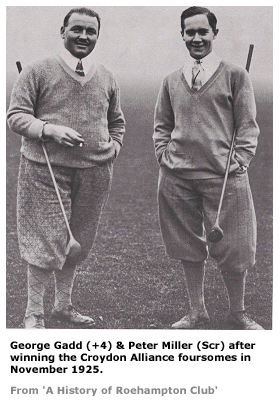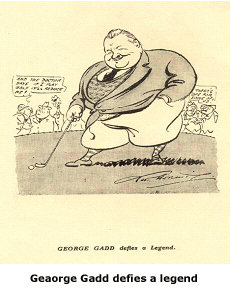|
 After
two years it was time for me to move on and in 1926, the year of the
General Strike, I departed for London to join brother George at the
Roehampton Club, where I was to replace my elder brother Jack as
assistant. Roehampton is a prestigious sports club whose captains
have included the then Duke of York, later King George V1, Prime
Minister David Lloyd-George and Admiral Jellicoe, who I remember
would run round the course like a rabbit; He was very careful with
his money and would not take a caddie. I became the fourth Gadd to
serve the club as during the war Charles had been repatriated to the
military hospital at Roehampton for treatment to his wound and had
afterwards acted as professional until George was demobilised. My
move to Roehampton had been planned, but I believe that it was
brought forward after I applied to join the Mounties. So I left
Brancepeth little realising that my connection with the club would
be renewed many years later by a quirk of fate. After
two years it was time for me to move on and in 1926, the year of the
General Strike, I departed for London to join brother George at the
Roehampton Club, where I was to replace my elder brother Jack as
assistant. Roehampton is a prestigious sports club whose captains
have included the then Duke of York, later King George V1, Prime
Minister David Lloyd-George and Admiral Jellicoe, who I remember
would run round the course like a rabbit; He was very careful with
his money and would not take a caddie. I became the fourth Gadd to
serve the club as during the war Charles had been repatriated to the
military hospital at Roehampton for treatment to his wound and had
afterwards acted as professional until George was demobilised. My
move to Roehampton had been planned, but I believe that it was
brought forward after I applied to join the Mounties. So I left
Brancepeth little realising that my connection with the club would
be renewed many years later by a quirk of fate.
 George
cut a cheerful chubby figure and was often depicted in cartoons in
those days. He was included in Bernard Darwin’s list of ‘Great
Players’ -“an eminently solid one”, he said, “with a characteristic
style and flourish of his own”. In 1912 he came up against the Tiger
of the day, Harry Vardon, in the News of the World match-play
tournament at Sunningdale. Like most of Vardon’s opponents he lost
and the great man went on to take yet another title. [In 1913, while
at Wrexham, he and his partner beat James Braid and partner in a
foursomes at Deal and George consistently out-drove Braid]. George
won the Welsh Professional championship (played that year at Chester
GC, whose course was in the North Wales county of Flintshire at that
time) before being appointed to Roehampton in 1914, just as war
broke out. He joined the Welsh Fusiliers and served as a Lieutenant.
He was on the RMS Leinster when she was torpedoed in the Irish Sea
and was adrift on a raft for eight hours before being rescued. [Of
the 771 passengers 500 lives were lost and George was one of only
six survivors from the twenty-two members of his regiment on board].
The 'Leinster' was sunk in October 1918 when the war was nearing its
end and deep indignation was felt in Ireland at their first real
blow from 'German barbarity'. George
cut a cheerful chubby figure and was often depicted in cartoons in
those days. He was included in Bernard Darwin’s list of ‘Great
Players’ -“an eminently solid one”, he said, “with a characteristic
style and flourish of his own”. In 1912 he came up against the Tiger
of the day, Harry Vardon, in the News of the World match-play
tournament at Sunningdale. Like most of Vardon’s opponents he lost
and the great man went on to take yet another title. [In 1913, while
at Wrexham, he and his partner beat James Braid and partner in a
foursomes at Deal and George consistently out-drove Braid]. George
won the Welsh Professional championship (played that year at Chester
GC, whose course was in the North Wales county of Flintshire at that
time) before being appointed to Roehampton in 1914, just as war
broke out. He joined the Welsh Fusiliers and served as a Lieutenant.
He was on the RMS Leinster when she was torpedoed in the Irish Sea
and was adrift on a raft for eight hours before being rescued. [Of
the 771 passengers 500 lives were lost and George was one of only
six survivors from the twenty-two members of his regiment on board].
The 'Leinster' was sunk in October 1918 when the war was nearing its
end and deep indignation was felt in Ireland at their first real
blow from 'German barbarity'.
NEXT |